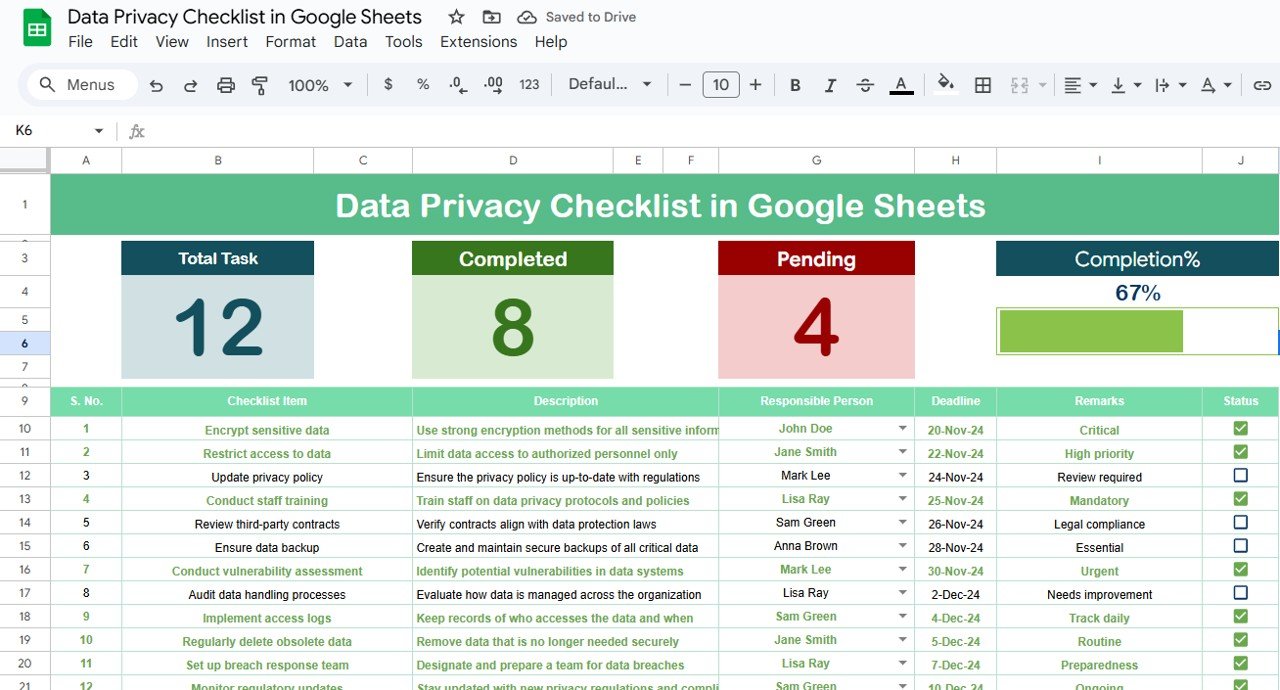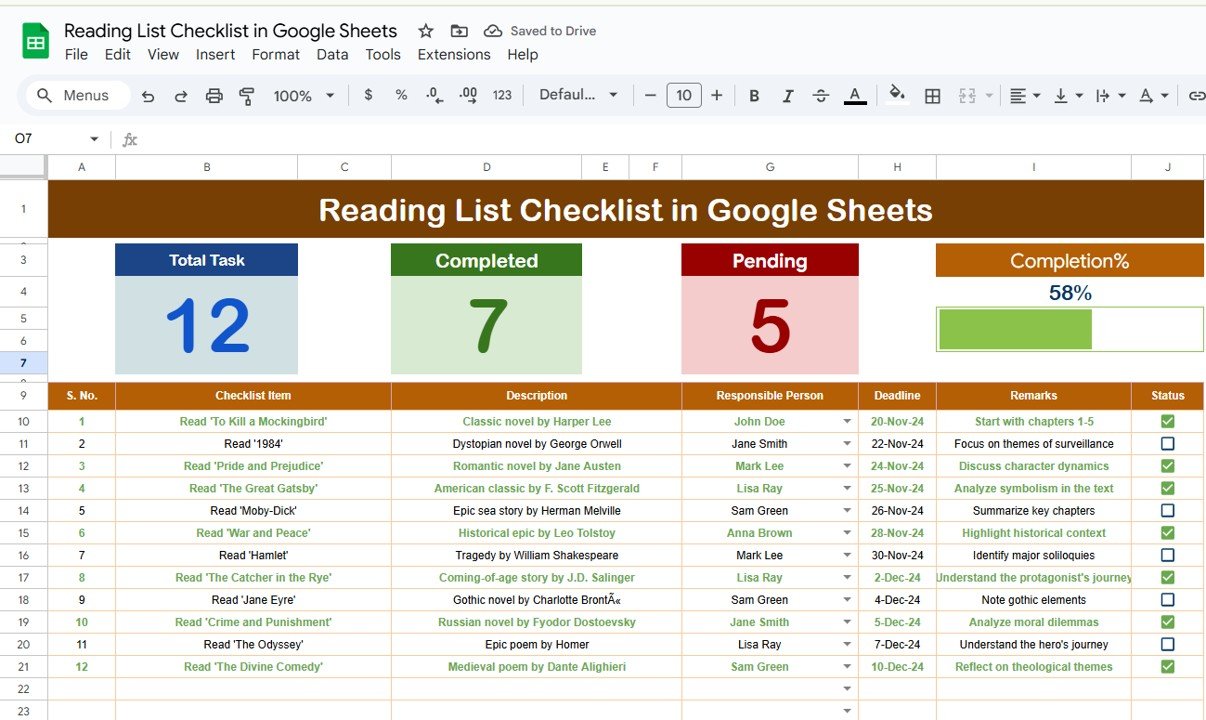In today’s digital age, data privacy has become a critical aspect of every business, regardless of its size or industry. With the increasing number of data breaches and strict regulations like GDPR (General Data Protection Regulation), businesses must take the necessary steps to ensure that personal and sensitive data is well protected. One effective way to manage and monitor data privacy compliance is by using a Data Privacy Checklist in Google Sheets.
A Data Privacy Checklist in Google Sheets provides a simple yet efficient tool for tracking and maintaining data privacy protocols. It helps organizations stay on top of their data protection tasks and ensures they comply with relevant laws and regulations. In this article, we will explore the key features, advantages, opportunities for improvement, and best practices for creating and using a Data Privacy Checklist in Google Sheets.
What is a Data Privacy Checklist in Google Sheets?
A Data Privacy Checklist in Google Sheets is a digital tool used to monitor the implementation of data protection policies and procedures. It includes a series of tasks, checkpoints, and standards that organizations must meet to ensure the privacy and security of personal data.
By using Google Sheets, businesses can easily track and update their compliance with data privacy laws, assign responsibilities, and monitor deadlines. Google Sheets’ collaborative nature also allows multiple team members to contribute, making it an ideal platform for cross-functional teams to stay aligned and informed.
Key Features of the Data Privacy Checklist in Google Sheets
The Data Privacy Checklist in Google Sheets template is designed with ease of use and efficiency in mind. It consists of two main worksheets that help businesses track, manage, and report their data privacy activities.
1. Data Privacy Checklist Sheet Tab
This is the main worksheet where all the essential checklist information is captured. The top section of the sheet includes:
-
Total Count: Displays the total number of checklist items.
-
Completed Count: Shows how many tasks have been completed.
-
Pending Count: Indicates the number of tasks that are still pending.
-
Progress Bar: A visual representation of the percentage of tasks completed.
Checklist Table
In the checklist table, users can update the status of each item as either ✔ (Completed) or ✘ (Not Completed). The table consists of the following columns:
-
Serial No.: A unique identifier for each checklist item.
-
Checklist Item: The specific data privacy task or protocol to be completed.
-
Description: A brief description of what needs to be done.
-
Responsible Person: The individual assigned to complete the task.
-
Deadline: The due date for task completion.
-
Remarks: Additional notes or instructions related to the task.
-
Status: Whether the task is completed (✔) or not (✘).

Click to buy Data Privacy Checklist in Google Sheets
2. List Sheet Tab
This sheet contains a unique list of responsible individuals. The names from this list are used to create a drop-down list in the Data Privacy Checklist Sheet. This feature allows users to assign specific tasks to individuals in a consistent and organized manner.

Click to buy Data Privacy Checklist in Google Sheets
Advantages of Using a Data Privacy Checklist in Google Sheets
A Data Privacy Checklist in Google Sheets offers numerous advantages that help businesses maintain robust data privacy practices:
- Centralized Data Management: By using a single template to track data privacy tasks, organizations can centralize all their data protection activities in one place. This makes it easy to update, monitor, and share information across teams.
- Real-Time Collaboration: Google Sheets allows multiple users to work on the checklist simultaneously, ensuring that team members can collaborate in real-time. This helps improve communication, ensure that everyone is on the same page, and avoid duplication of effort.
- Cost-Effective Solution: Google Sheets is a free tool, making it an affordable option for businesses of all sizes. It provides robust functionality without the need for expensive software solutions, making it ideal for small to medium-sized businesses.
- Ease of Use: Google Sheets is user-friendly, and the template is easy to set up and customize. Whether you are a business owner, a data privacy officer, or a compliance manager, you can quickly adapt the checklist to your specific needs.
- Flexible and Customizable: The template can be tailored to suit your company’s specific data privacy needs. You can add or remove checklist items, modify deadlines, and customize the task assignment to fit your team structure.
Opportunities for Improvement in Data Privacy Checklists
While the Data Privacy Checklist in Google Sheets is an excellent tool for managing data protection tasks, there are always opportunities to enhance its functionality and make it even more effective. Here are some areas for improvement:
- Integration with Other Tools: Integrating the checklist with other tools like CRM, ERP, or project management software can help automate data entry and improve accuracy. This integration would allow for seamless data flow across various systems and reduce the need for manual updates.
- Advanced Reporting Features: Adding advanced reporting features like trend analysis or monthly summaries can help track the progress of data privacy initiatives over time. This can provide insights into which areas of data protection require more attention or resources.
- Mobile Optimization: Optimizing the checklist for mobile devices would allow employees and managers to access and update the checklist on-the-go. This would enhance accessibility and convenience, especially for teams working remotely or in the field.
- Real-Time Data Updates: Implementing real-time data updates would ensure that the checklist always reflects the most up-to-date information. This can help organizations respond quickly to any new data privacy regulations or immediate action items.
Best Practices for Using the Data Privacy Checklist
Click to buy Data Privacy Checklist in Google Sheets
To ensure that your Data Privacy Checklist in Google Sheets is effective and provides maximum value, follow these best practices:
- Clearly Define Data Privacy Tasks: Each checklist item should be well-defined and aligned with your organization’s data privacy goals. Make sure that each task is measurable and actionable to avoid confusion and ensure accountability.
- Regularly Update the Checklist: Data privacy is an ongoing concern. Regularly update the checklist to reflect changes in regulations, processes, or technologies. A stale checklist can lead to missed compliance requirements and potential security risks.
- Assign Clear Responsibilities: Assign each task to a specific person and ensure that responsibilities are clearly communicated. This helps prevent overlapping work and ensures that every task is completed on time.
- Set Realistic Deadlines: Make sure the deadlines for each task are reasonable and achievable. Having realistic timeframes ensures that team members can complete tasks without unnecessary stress and that the checklist remains actionable.
- Use Conditional Formatting: Leverage conditional formatting features in Google Sheets to highlight overdue tasks or tasks that require immediate attention. This can help make the checklist more visually appealing and easier to navigate.
- Track Progress Over Time: Use the progress bar and status columns to track the completion rate of each task. This helps you monitor your team’s progress and identify areas where additional resources or attention may be needed.
- Ensure Data Security: Since the checklist will likely contain sensitive data, make sure to implement appropriate security measures. Limit access to authorized personnel only and consider using password protection for the Google Sheet.
Conclusion
The Data Privacy Checklist in Google Sheets is an invaluable tool for organizations looking to maintain strong data protection practices. It provides a simple, cost-effective solution for tracking data privacy tasks, ensuring compliance with regulations, and improving accountability. By following the best practices and continuously improving the checklist, you can ensure that your business remains secure and compliant in today’s ever-evolving data privacy landscape.
Frequently Asked Questions (FAQs)
1. What is a Data Privacy Checklist in Google Sheets?
A Data Privacy Checklist in Google Sheets is a tool that helps organizations track and manage tasks related to data protection and privacy compliance.
2. How can I use Google Sheets for my Data Privacy Checklist?
Google Sheets allows you to create, customize, and manage your data privacy checklist. You can update the checklist in real-time, assign tasks, and monitor progress all in one place.
3. Can I customize the Data Privacy Checklist for my company?
Yes, you can easily customize the checklist to suit your organization’s specific data privacy needs. You can modify tasks, deadlines, and responsibilities as necessary.
4. How often should I update the Data Privacy Checklist?
The checklist should be updated regularly, especially when there are changes in data privacy laws or internal processes. It’s recommended to review and update it at least quarterly.
5. Is the Data Privacy Checklist in Google Sheets mobile-friendly?
Yes, since Google Sheets is cloud-based, you can access and update your checklist from any device, including mobile phones, making it easy to manage tasks on the go.
Visit our YouTube channel to learn step-by-step video tutorials
Youtube.com/@NeotechNavigators
Click to buy Data Privacy Checklist in Google Sheets



